Leadership for Change: Analysis of Key Factors and Strategies
VerifiedAdded on 2023/04/20
|13
|2890
|469
Report
AI Summary
This report provides an in-depth analysis of the critical role of leadership in change management within organizations. It explores how leadership shapes organizational change, emphasizing the need for adaptability and the influence of factors such as teamwork, organizational culture, communication, and trust. The report delves into different leadership styles, the importance of continuous learning, and the impact of leadership sensing paradoxes. It also debunks myths surrounding change leadership, highlighting the significance of both leadership and management. Recommendations include adopting a broad perspective on leadership, ensuring positive attitudes, fostering trust, encouraging communication, and managing risks. The report concludes that effective leadership is essential for navigating change successfully, offering insights into strategies for implementation and the importance of a flexible approach.

Title: Leadership for change
1 | P a g e
1 | P a g e
Paraphrase This Document
Need a fresh take? Get an instant paraphrase of this document with our AI Paraphraser
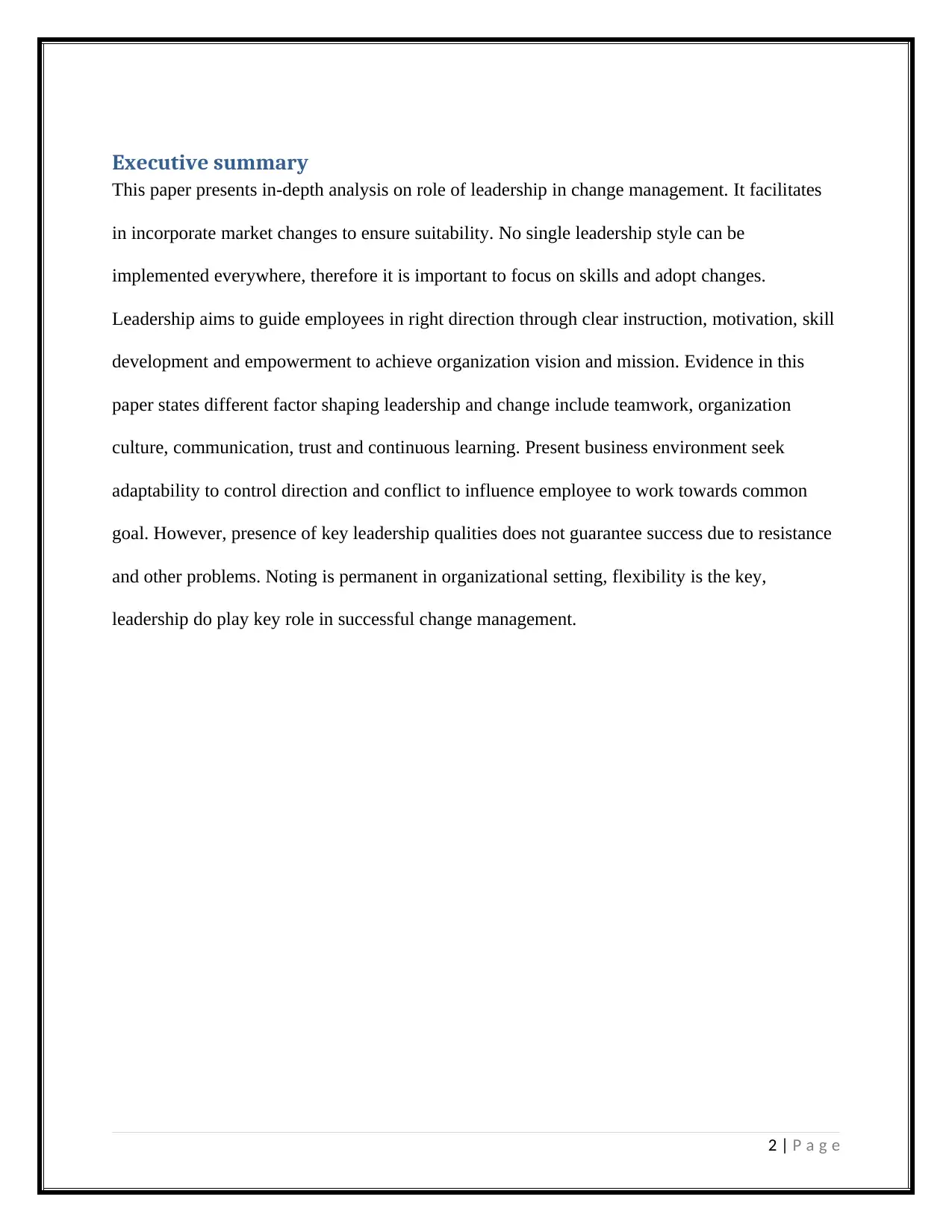
Executive summary
This paper presents in-depth analysis on role of leadership in change management. It facilitates
in incorporate market changes to ensure suitability. No single leadership style can be
implemented everywhere, therefore it is important to focus on skills and adopt changes.
Leadership aims to guide employees in right direction through clear instruction, motivation, skill
development and empowerment to achieve organization vision and mission. Evidence in this
paper states different factor shaping leadership and change include teamwork, organization
culture, communication, trust and continuous learning. Present business environment seek
adaptability to control direction and conflict to influence employee to work towards common
goal. However, presence of key leadership qualities does not guarantee success due to resistance
and other problems. Noting is permanent in organizational setting, flexibility is the key,
leadership do play key role in successful change management.
2 | P a g e
This paper presents in-depth analysis on role of leadership in change management. It facilitates
in incorporate market changes to ensure suitability. No single leadership style can be
implemented everywhere, therefore it is important to focus on skills and adopt changes.
Leadership aims to guide employees in right direction through clear instruction, motivation, skill
development and empowerment to achieve organization vision and mission. Evidence in this
paper states different factor shaping leadership and change include teamwork, organization
culture, communication, trust and continuous learning. Present business environment seek
adaptability to control direction and conflict to influence employee to work towards common
goal. However, presence of key leadership qualities does not guarantee success due to resistance
and other problems. Noting is permanent in organizational setting, flexibility is the key,
leadership do play key role in successful change management.
2 | P a g e
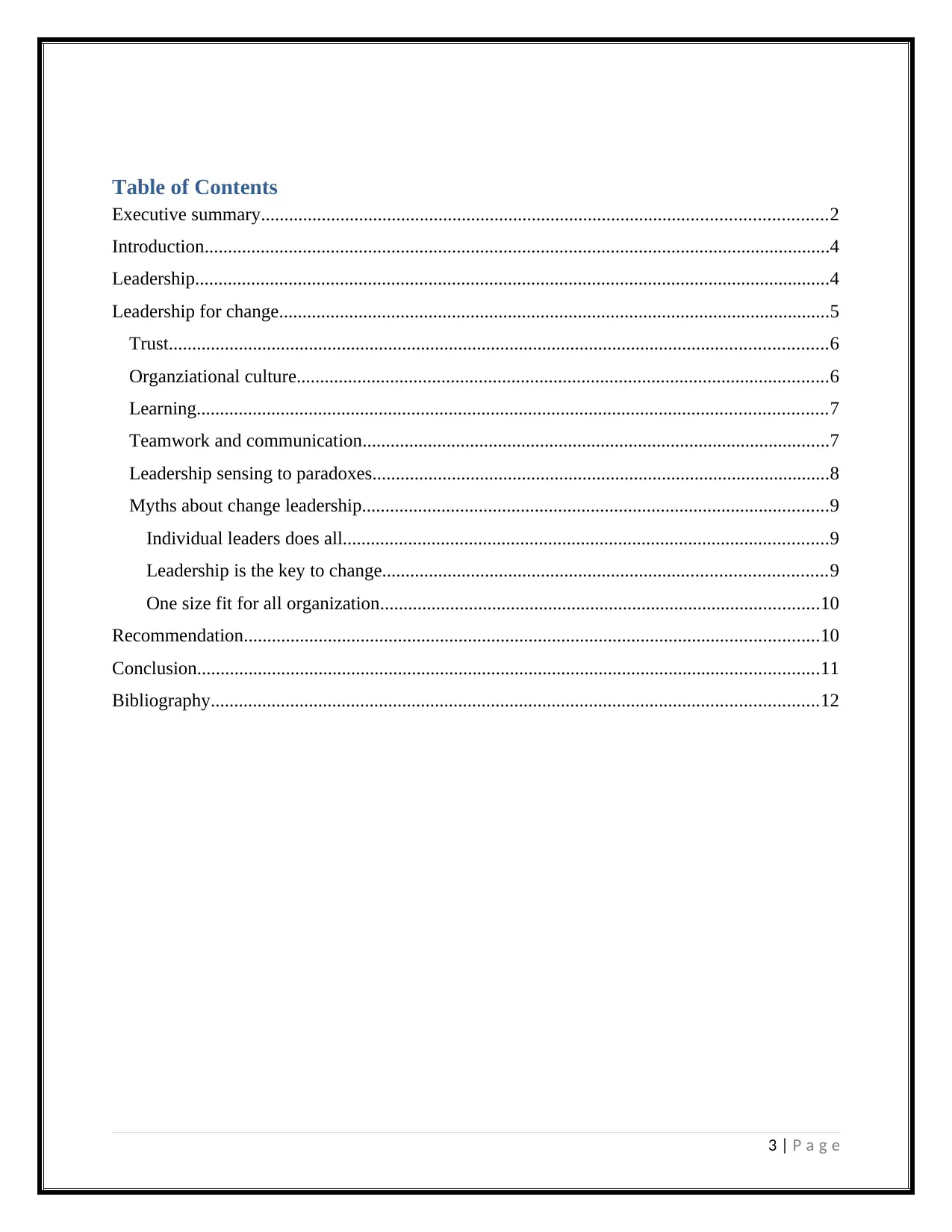
Table of Contents
Executive summary.........................................................................................................................2
Introduction......................................................................................................................................4
Leadership........................................................................................................................................4
Leadership for change......................................................................................................................5
Trust.............................................................................................................................................6
Organziational culture..................................................................................................................6
Learning.......................................................................................................................................7
Teamwork and communication....................................................................................................7
Leadership sensing to paradoxes..................................................................................................8
Myths about change leadership....................................................................................................9
Individual leaders does all........................................................................................................9
Leadership is the key to change...............................................................................................9
One size fit for all organization..............................................................................................10
Recommendation...........................................................................................................................10
Conclusion.....................................................................................................................................11
Bibliography..................................................................................................................................12
3 | P a g e
Executive summary.........................................................................................................................2
Introduction......................................................................................................................................4
Leadership........................................................................................................................................4
Leadership for change......................................................................................................................5
Trust.............................................................................................................................................6
Organziational culture..................................................................................................................6
Learning.......................................................................................................................................7
Teamwork and communication....................................................................................................7
Leadership sensing to paradoxes..................................................................................................8
Myths about change leadership....................................................................................................9
Individual leaders does all........................................................................................................9
Leadership is the key to change...............................................................................................9
One size fit for all organization..............................................................................................10
Recommendation...........................................................................................................................10
Conclusion.....................................................................................................................................11
Bibliography..................................................................................................................................12
3 | P a g e
⊘ This is a preview!⊘
Do you want full access?
Subscribe today to unlock all pages.

Trusted by 1+ million students worldwide
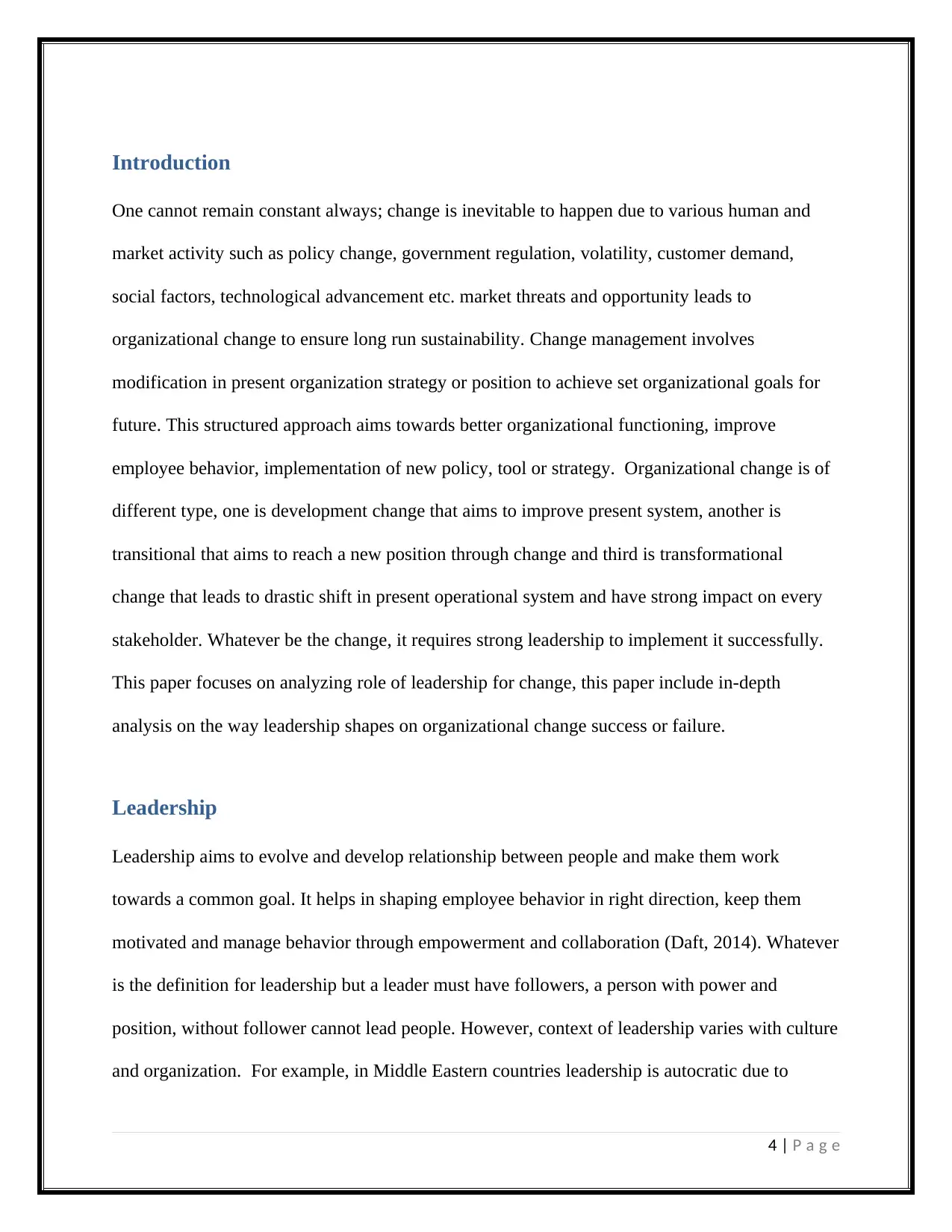
Introduction
One cannot remain constant always; change is inevitable to happen due to various human and
market activity such as policy change, government regulation, volatility, customer demand,
social factors, technological advancement etc. market threats and opportunity leads to
organizational change to ensure long run sustainability. Change management involves
modification in present organization strategy or position to achieve set organizational goals for
future. This structured approach aims towards better organizational functioning, improve
employee behavior, implementation of new policy, tool or strategy. Organizational change is of
different type, one is development change that aims to improve present system, another is
transitional that aims to reach a new position through change and third is transformational
change that leads to drastic shift in present operational system and have strong impact on every
stakeholder. Whatever be the change, it requires strong leadership to implement it successfully.
This paper focuses on analyzing role of leadership for change, this paper include in-depth
analysis on the way leadership shapes on organizational change success or failure.
Leadership
Leadership aims to evolve and develop relationship between people and make them work
towards a common goal. It helps in shaping employee behavior in right direction, keep them
motivated and manage behavior through empowerment and collaboration (Daft, 2014). Whatever
is the definition for leadership but a leader must have followers, a person with power and
position, without follower cannot lead people. However, context of leadership varies with culture
and organization. For example, in Middle Eastern countries leadership is autocratic due to
4 | P a g e
One cannot remain constant always; change is inevitable to happen due to various human and
market activity such as policy change, government regulation, volatility, customer demand,
social factors, technological advancement etc. market threats and opportunity leads to
organizational change to ensure long run sustainability. Change management involves
modification in present organization strategy or position to achieve set organizational goals for
future. This structured approach aims towards better organizational functioning, improve
employee behavior, implementation of new policy, tool or strategy. Organizational change is of
different type, one is development change that aims to improve present system, another is
transitional that aims to reach a new position through change and third is transformational
change that leads to drastic shift in present operational system and have strong impact on every
stakeholder. Whatever be the change, it requires strong leadership to implement it successfully.
This paper focuses on analyzing role of leadership for change, this paper include in-depth
analysis on the way leadership shapes on organizational change success or failure.
Leadership
Leadership aims to evolve and develop relationship between people and make them work
towards a common goal. It helps in shaping employee behavior in right direction, keep them
motivated and manage behavior through empowerment and collaboration (Daft, 2014). Whatever
is the definition for leadership but a leader must have followers, a person with power and
position, without follower cannot lead people. However, context of leadership varies with culture
and organization. For example, in Middle Eastern countries leadership is autocratic due to
4 | P a g e
Paraphrase This Document
Need a fresh take? Get an instant paraphrase of this document with our AI Paraphraser
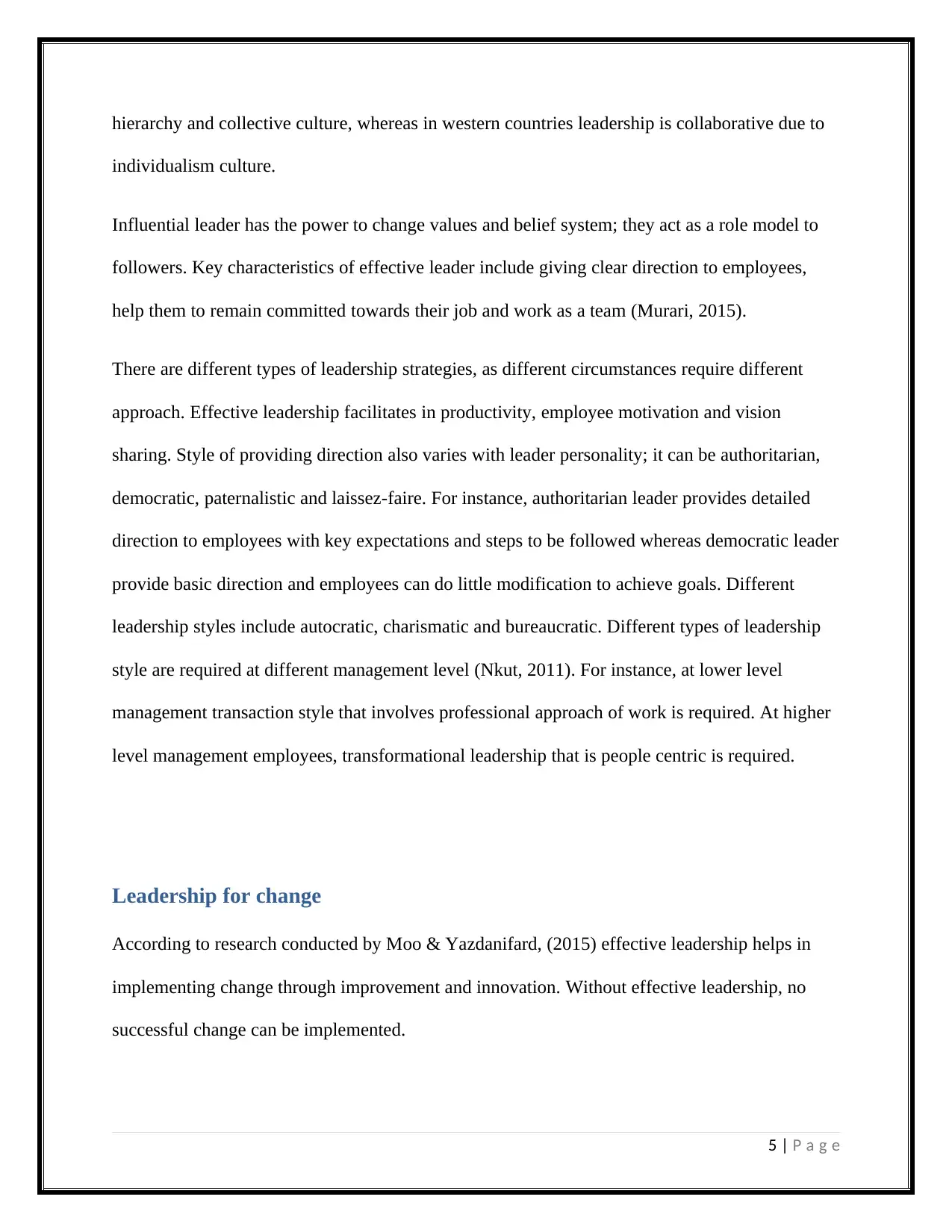
hierarchy and collective culture, whereas in western countries leadership is collaborative due to
individualism culture.
Influential leader has the power to change values and belief system; they act as a role model to
followers. Key characteristics of effective leader include giving clear direction to employees,
help them to remain committed towards their job and work as a team (Murari, 2015).
There are different types of leadership strategies, as different circumstances require different
approach. Effective leadership facilitates in productivity, employee motivation and vision
sharing. Style of providing direction also varies with leader personality; it can be authoritarian,
democratic, paternalistic and laissez-faire. For instance, authoritarian leader provides detailed
direction to employees with key expectations and steps to be followed whereas democratic leader
provide basic direction and employees can do little modification to achieve goals. Different
leadership styles include autocratic, charismatic and bureaucratic. Different types of leadership
style are required at different management level (Nkut, 2011). For instance, at lower level
management transaction style that involves professional approach of work is required. At higher
level management employees, transformational leadership that is people centric is required.
Leadership for change
According to research conducted by Moo & Yazdanifard, (2015) effective leadership helps in
implementing change through improvement and innovation. Without effective leadership, no
successful change can be implemented.
5 | P a g e
individualism culture.
Influential leader has the power to change values and belief system; they act as a role model to
followers. Key characteristics of effective leader include giving clear direction to employees,
help them to remain committed towards their job and work as a team (Murari, 2015).
There are different types of leadership strategies, as different circumstances require different
approach. Effective leadership facilitates in productivity, employee motivation and vision
sharing. Style of providing direction also varies with leader personality; it can be authoritarian,
democratic, paternalistic and laissez-faire. For instance, authoritarian leader provides detailed
direction to employees with key expectations and steps to be followed whereas democratic leader
provide basic direction and employees can do little modification to achieve goals. Different
leadership styles include autocratic, charismatic and bureaucratic. Different types of leadership
style are required at different management level (Nkut, 2011). For instance, at lower level
management transaction style that involves professional approach of work is required. At higher
level management employees, transformational leadership that is people centric is required.
Leadership for change
According to research conducted by Moo & Yazdanifard, (2015) effective leadership helps in
implementing change through improvement and innovation. Without effective leadership, no
successful change can be implemented.
5 | P a g e
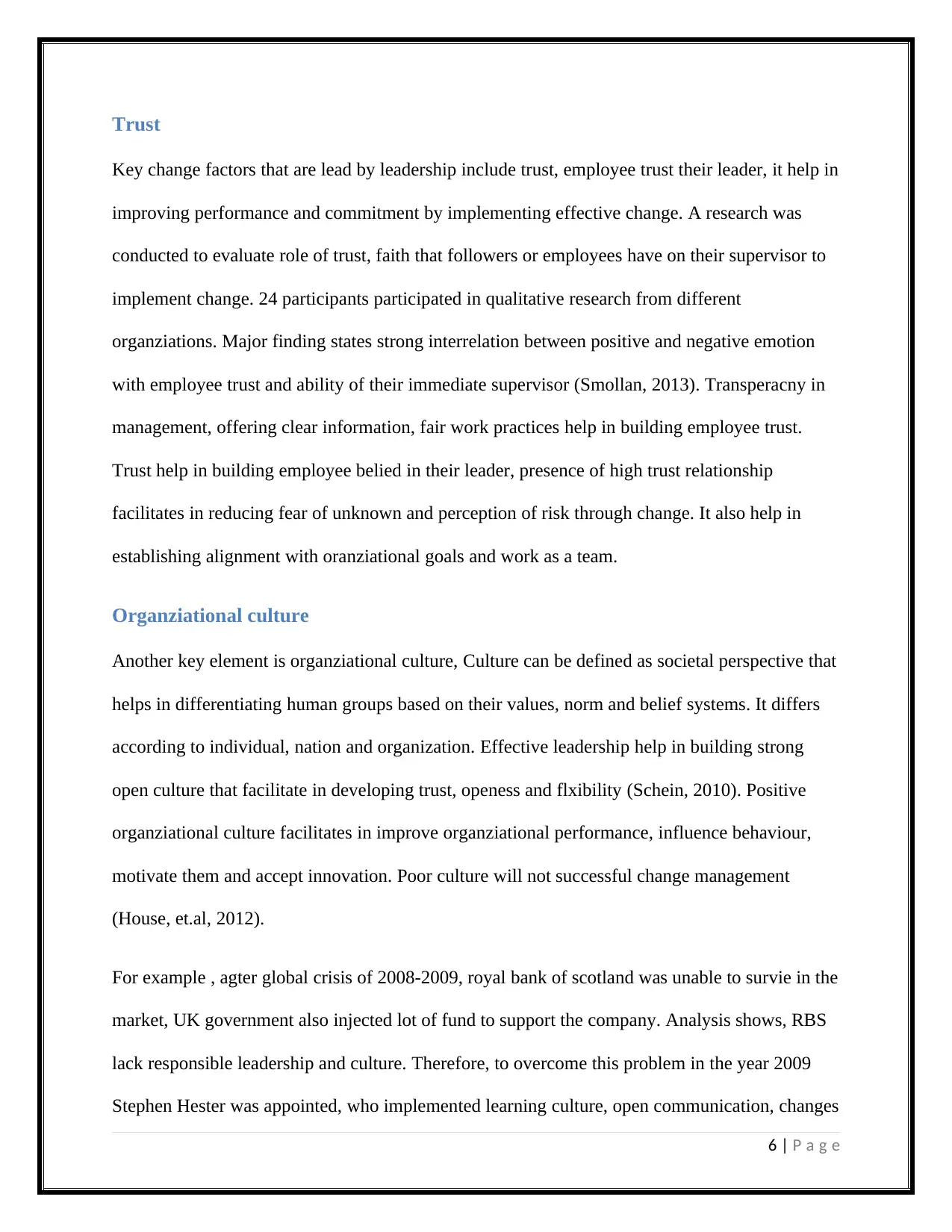
Trust
Key change factors that are lead by leadership include trust, employee trust their leader, it help in
improving performance and commitment by implementing effective change. A research was
conducted to evaluate role of trust, faith that followers or employees have on their supervisor to
implement change. 24 participants participated in qualitative research from different
organziations. Major finding states strong interrelation between positive and negative emotion
with employee trust and ability of their immediate supervisor (Smollan, 2013). Transperacny in
management, offering clear information, fair work practices help in building employee trust.
Trust help in building employee belied in their leader, presence of high trust relationship
facilitates in reducing fear of unknown and perception of risk through change. It also help in
establishing alignment with oranziational goals and work as a team.
Organziational culture
Another key element is organziational culture, Culture can be defined as societal perspective that
helps in differentiating human groups based on their values, norm and belief systems. It differs
according to individual, nation and organization. Effective leadership help in building strong
open culture that facilitate in developing trust, openess and flxibility (Schein, 2010). Positive
organziational culture facilitates in improve organziational performance, influence behaviour,
motivate them and accept innovation. Poor culture will not successful change management
(House, et.al, 2012).
For example , agter global crisis of 2008-2009, royal bank of scotland was unable to survie in the
market, UK government also injected lot of fund to support the company. Analysis shows, RBS
lack responsible leadership and culture. Therefore, to overcome this problem in the year 2009
Stephen Hester was appointed, who implemented learning culture, open communication, changes
6 | P a g e
Key change factors that are lead by leadership include trust, employee trust their leader, it help in
improving performance and commitment by implementing effective change. A research was
conducted to evaluate role of trust, faith that followers or employees have on their supervisor to
implement change. 24 participants participated in qualitative research from different
organziations. Major finding states strong interrelation between positive and negative emotion
with employee trust and ability of their immediate supervisor (Smollan, 2013). Transperacny in
management, offering clear information, fair work practices help in building employee trust.
Trust help in building employee belied in their leader, presence of high trust relationship
facilitates in reducing fear of unknown and perception of risk through change. It also help in
establishing alignment with oranziational goals and work as a team.
Organziational culture
Another key element is organziational culture, Culture can be defined as societal perspective that
helps in differentiating human groups based on their values, norm and belief systems. It differs
according to individual, nation and organization. Effective leadership help in building strong
open culture that facilitate in developing trust, openess and flxibility (Schein, 2010). Positive
organziational culture facilitates in improve organziational performance, influence behaviour,
motivate them and accept innovation. Poor culture will not successful change management
(House, et.al, 2012).
For example , agter global crisis of 2008-2009, royal bank of scotland was unable to survie in the
market, UK government also injected lot of fund to support the company. Analysis shows, RBS
lack responsible leadership and culture. Therefore, to overcome this problem in the year 2009
Stephen Hester was appointed, who implemented learning culture, open communication, changes
6 | P a g e
⊘ This is a preview!⊘
Do you want full access?
Subscribe today to unlock all pages.

Trusted by 1+ million students worldwide
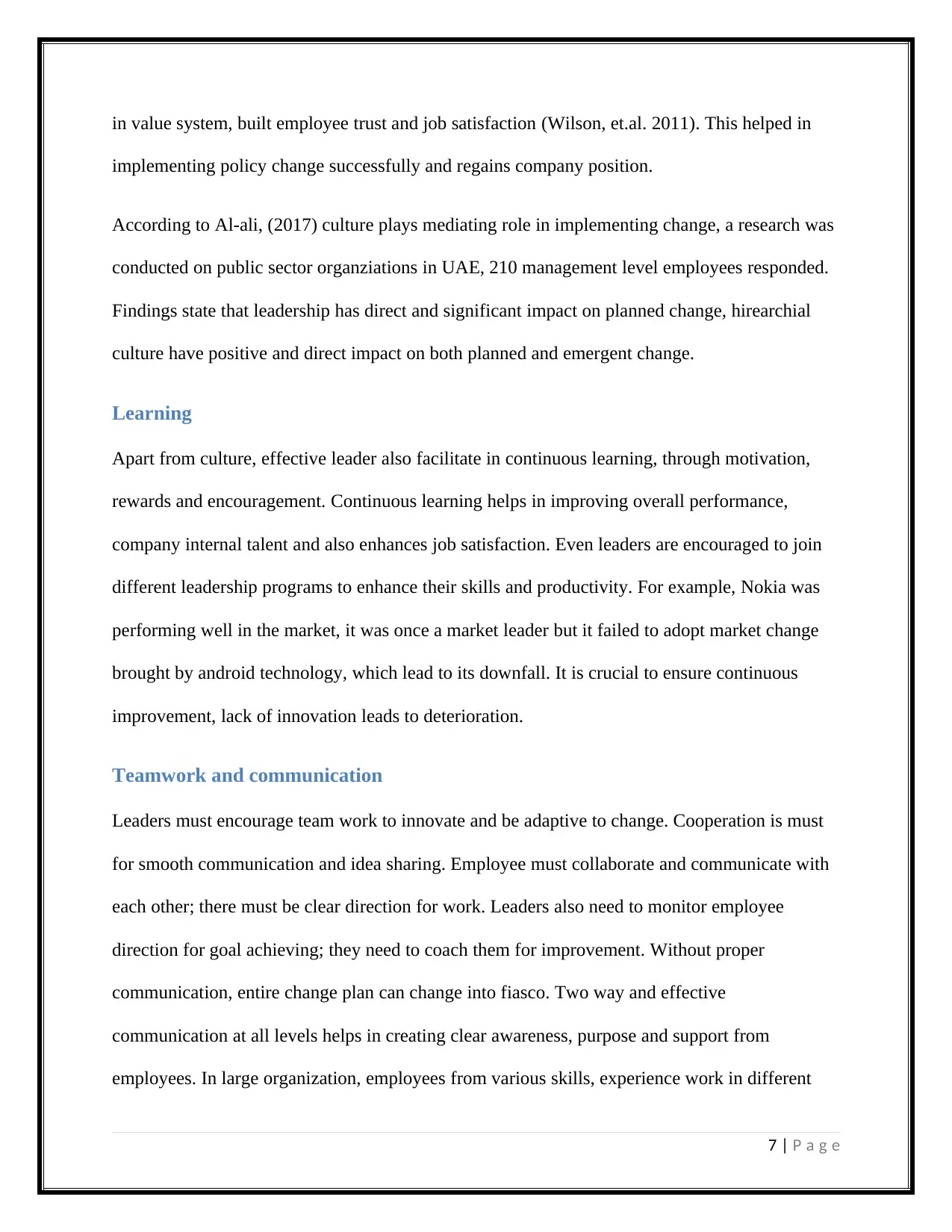
in value system, built employee trust and job satisfaction (Wilson, et.al. 2011). This helped in
implementing policy change successfully and regains company position.
According to Al-ali, (2017) culture plays mediating role in implementing change, a research was
conducted on public sector organziations in UAE, 210 management level employees responded.
Findings state that leadership has direct and significant impact on planned change, hirearchial
culture have positive and direct impact on both planned and emergent change.
Learning
Apart from culture, effective leader also facilitate in continuous learning, through motivation,
rewards and encouragement. Continuous learning helps in improving overall performance,
company internal talent and also enhances job satisfaction. Even leaders are encouraged to join
different leadership programs to enhance their skills and productivity. For example, Nokia was
performing well in the market, it was once a market leader but it failed to adopt market change
brought by android technology, which lead to its downfall. It is crucial to ensure continuous
improvement, lack of innovation leads to deterioration.
Teamwork and communication
Leaders must encourage team work to innovate and be adaptive to change. Cooperation is must
for smooth communication and idea sharing. Employee must collaborate and communicate with
each other; there must be clear direction for work. Leaders also need to monitor employee
direction for goal achieving; they need to coach them for improvement. Without proper
communication, entire change plan can change into fiasco. Two way and effective
communication at all levels helps in creating clear awareness, purpose and support from
employees. In large organization, employees from various skills, experience work in different
7 | P a g e
implementing policy change successfully and regains company position.
According to Al-ali, (2017) culture plays mediating role in implementing change, a research was
conducted on public sector organziations in UAE, 210 management level employees responded.
Findings state that leadership has direct and significant impact on planned change, hirearchial
culture have positive and direct impact on both planned and emergent change.
Learning
Apart from culture, effective leader also facilitate in continuous learning, through motivation,
rewards and encouragement. Continuous learning helps in improving overall performance,
company internal talent and also enhances job satisfaction. Even leaders are encouraged to join
different leadership programs to enhance their skills and productivity. For example, Nokia was
performing well in the market, it was once a market leader but it failed to adopt market change
brought by android technology, which lead to its downfall. It is crucial to ensure continuous
improvement, lack of innovation leads to deterioration.
Teamwork and communication
Leaders must encourage team work to innovate and be adaptive to change. Cooperation is must
for smooth communication and idea sharing. Employee must collaborate and communicate with
each other; there must be clear direction for work. Leaders also need to monitor employee
direction for goal achieving; they need to coach them for improvement. Without proper
communication, entire change plan can change into fiasco. Two way and effective
communication at all levels helps in creating clear awareness, purpose and support from
employees. In large organization, employees from various skills, experience work in different
7 | P a g e
Paraphrase This Document
Need a fresh take? Get an instant paraphrase of this document with our AI Paraphraser
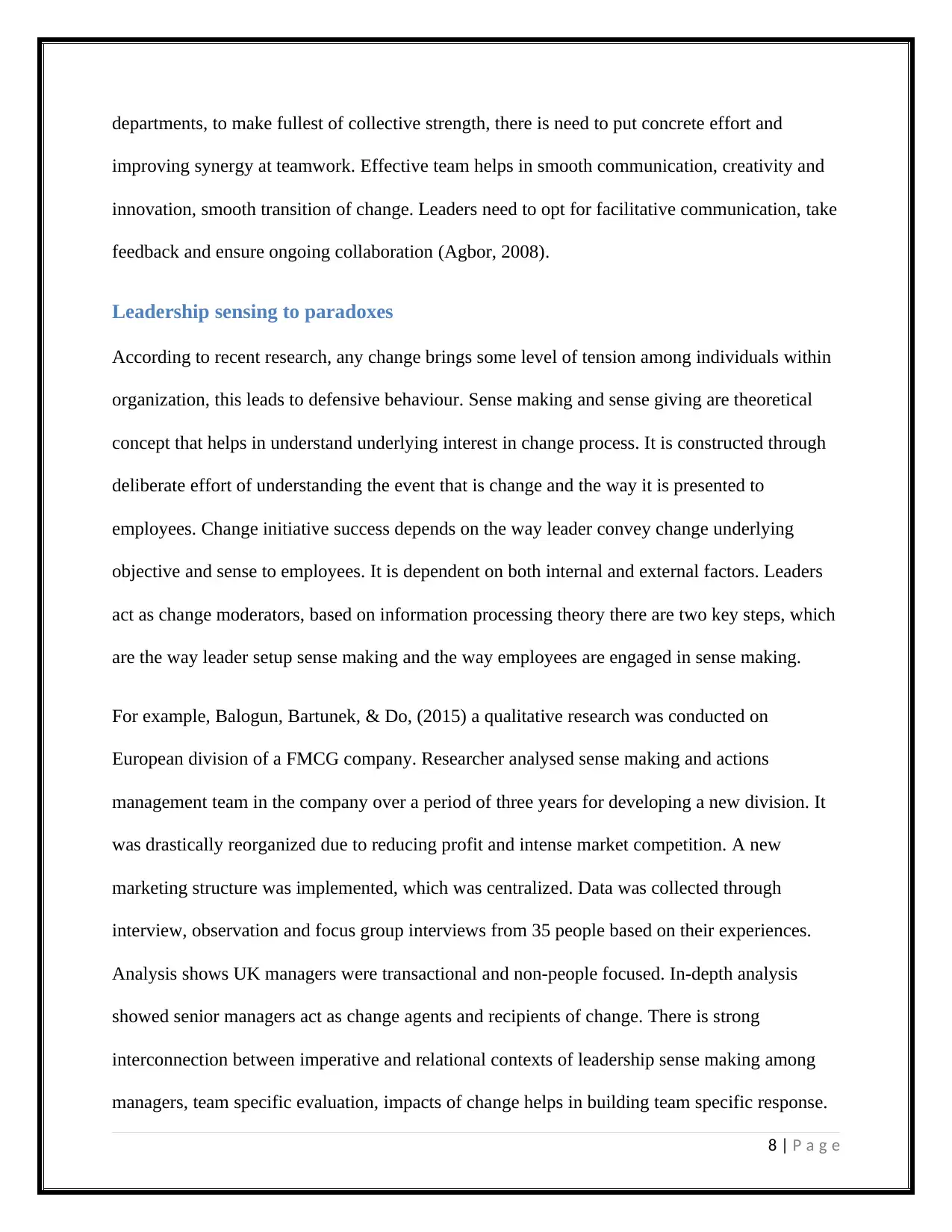
departments, to make fullest of collective strength, there is need to put concrete effort and
improving synergy at teamwork. Effective team helps in smooth communication, creativity and
innovation, smooth transition of change. Leaders need to opt for facilitative communication, take
feedback and ensure ongoing collaboration (Agbor, 2008).
Leadership sensing to paradoxes
According to recent research, any change brings some level of tension among individuals within
organization, this leads to defensive behaviour. Sense making and sense giving are theoretical
concept that helps in understand underlying interest in change process. It is constructed through
deliberate effort of understanding the event that is change and the way it is presented to
employees. Change initiative success depends on the way leader convey change underlying
objective and sense to employees. It is dependent on both internal and external factors. Leaders
act as change moderators, based on information processing theory there are two key steps, which
are the way leader setup sense making and the way employees are engaged in sense making.
For example, Balogun, Bartunek, & Do, (2015) a qualitative research was conducted on
European division of a FMCG company. Researcher analysed sense making and actions
management team in the company over a period of three years for developing a new division. It
was drastically reorganized due to reducing profit and intense market competition. A new
marketing structure was implemented, which was centralized. Data was collected through
interview, observation and focus group interviews from 35 people based on their experiences.
Analysis shows UK managers were transactional and non-people focused. In-depth analysis
showed senior managers act as change agents and recipients of change. There is strong
interconnection between imperative and relational contexts of leadership sense making among
managers, team specific evaluation, impacts of change helps in building team specific response.
8 | P a g e
improving synergy at teamwork. Effective team helps in smooth communication, creativity and
innovation, smooth transition of change. Leaders need to opt for facilitative communication, take
feedback and ensure ongoing collaboration (Agbor, 2008).
Leadership sensing to paradoxes
According to recent research, any change brings some level of tension among individuals within
organization, this leads to defensive behaviour. Sense making and sense giving are theoretical
concept that helps in understand underlying interest in change process. It is constructed through
deliberate effort of understanding the event that is change and the way it is presented to
employees. Change initiative success depends on the way leader convey change underlying
objective and sense to employees. It is dependent on both internal and external factors. Leaders
act as change moderators, based on information processing theory there are two key steps, which
are the way leader setup sense making and the way employees are engaged in sense making.
For example, Balogun, Bartunek, & Do, (2015) a qualitative research was conducted on
European division of a FMCG company. Researcher analysed sense making and actions
management team in the company over a period of three years for developing a new division. It
was drastically reorganized due to reducing profit and intense market competition. A new
marketing structure was implemented, which was centralized. Data was collected through
interview, observation and focus group interviews from 35 people based on their experiences.
Analysis shows UK managers were transactional and non-people focused. In-depth analysis
showed senior managers act as change agents and recipients of change. There is strong
interconnection between imperative and relational contexts of leadership sense making among
managers, team specific evaluation, impacts of change helps in building team specific response.
8 | P a g e
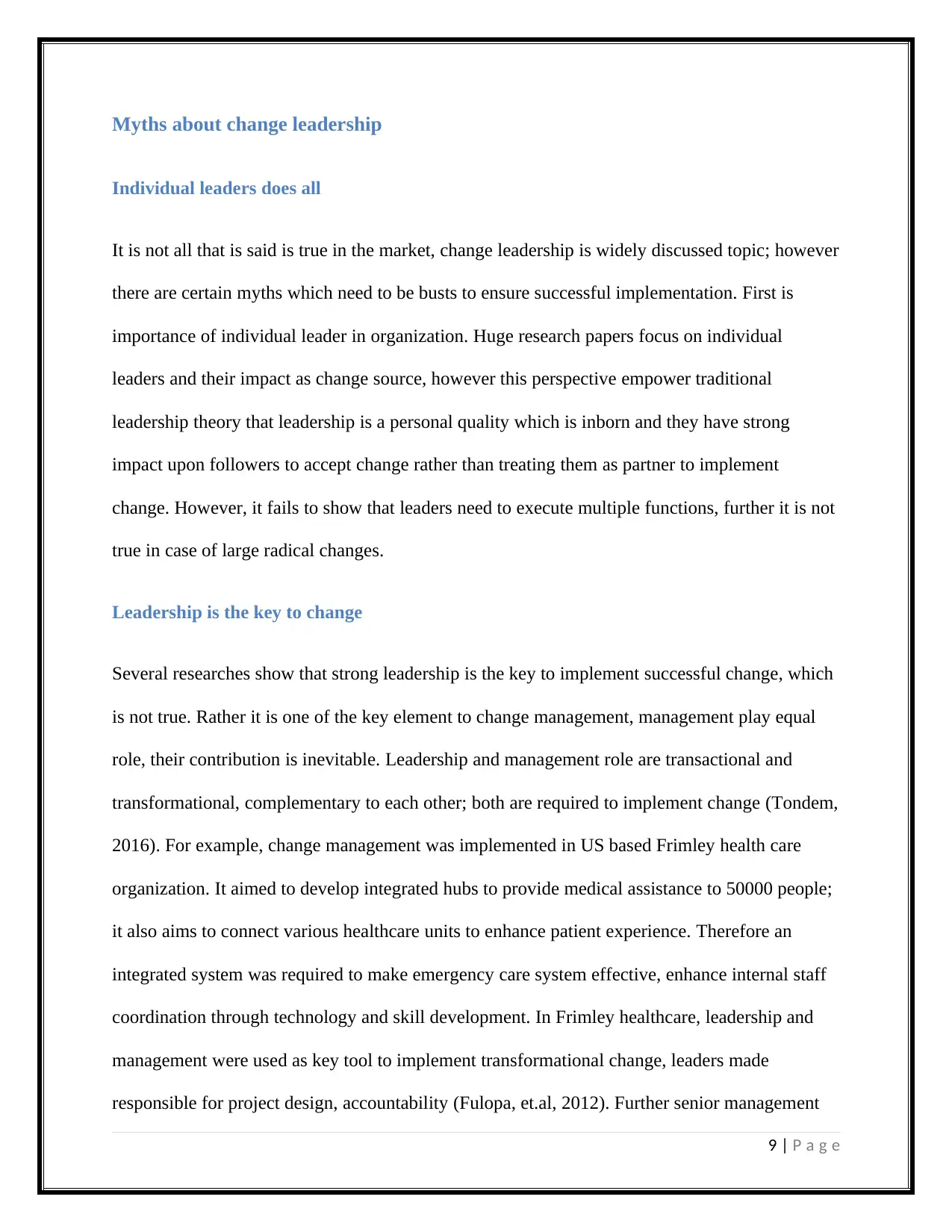
Myths about change leadership
Individual leaders does all
It is not all that is said is true in the market, change leadership is widely discussed topic; however
there are certain myths which need to be busts to ensure successful implementation. First is
importance of individual leader in organization. Huge research papers focus on individual
leaders and their impact as change source, however this perspective empower traditional
leadership theory that leadership is a personal quality which is inborn and they have strong
impact upon followers to accept change rather than treating them as partner to implement
change. However, it fails to show that leaders need to execute multiple functions, further it is not
true in case of large radical changes.
Leadership is the key to change
Several researches show that strong leadership is the key to implement successful change, which
is not true. Rather it is one of the key element to change management, management play equal
role, their contribution is inevitable. Leadership and management role are transactional and
transformational, complementary to each other; both are required to implement change (Tondem,
2016). For example, change management was implemented in US based Frimley health care
organization. It aimed to develop integrated hubs to provide medical assistance to 50000 people;
it also aims to connect various healthcare units to enhance patient experience. Therefore an
integrated system was required to make emergency care system effective, enhance internal staff
coordination through technology and skill development. In Frimley healthcare, leadership and
management were used as key tool to implement transformational change, leaders made
responsible for project design, accountability (Fulopa, et.al, 2012). Further senior management
9 | P a g e
Individual leaders does all
It is not all that is said is true in the market, change leadership is widely discussed topic; however
there are certain myths which need to be busts to ensure successful implementation. First is
importance of individual leader in organization. Huge research papers focus on individual
leaders and their impact as change source, however this perspective empower traditional
leadership theory that leadership is a personal quality which is inborn and they have strong
impact upon followers to accept change rather than treating them as partner to implement
change. However, it fails to show that leaders need to execute multiple functions, further it is not
true in case of large radical changes.
Leadership is the key to change
Several researches show that strong leadership is the key to implement successful change, which
is not true. Rather it is one of the key element to change management, management play equal
role, their contribution is inevitable. Leadership and management role are transactional and
transformational, complementary to each other; both are required to implement change (Tondem,
2016). For example, change management was implemented in US based Frimley health care
organization. It aimed to develop integrated hubs to provide medical assistance to 50000 people;
it also aims to connect various healthcare units to enhance patient experience. Therefore an
integrated system was required to make emergency care system effective, enhance internal staff
coordination through technology and skill development. In Frimley healthcare, leadership and
management were used as key tool to implement transformational change, leaders made
responsible for project design, accountability (Fulopa, et.al, 2012). Further senior management
9 | P a g e
⊘ This is a preview!⊘
Do you want full access?
Subscribe today to unlock all pages.

Trusted by 1+ million students worldwide
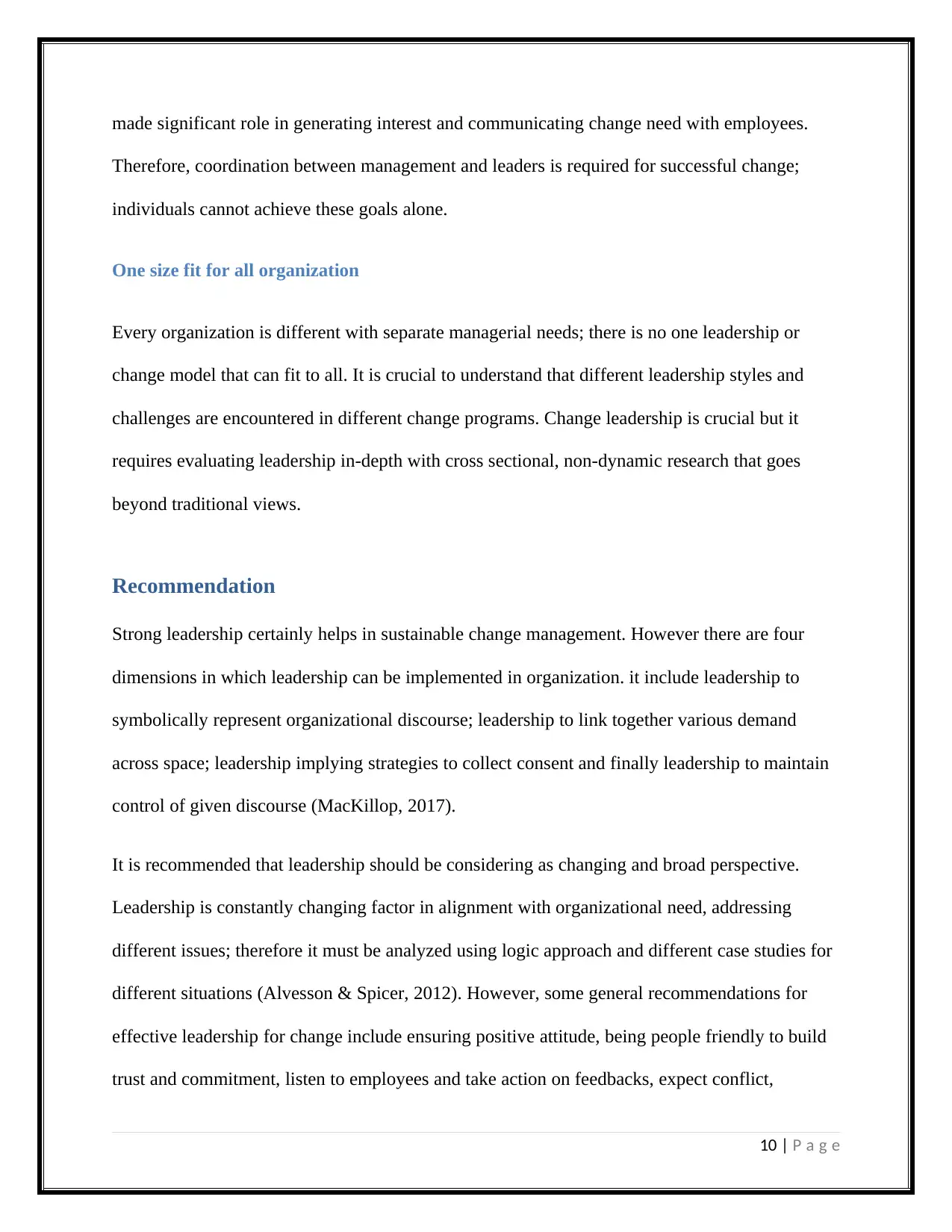
made significant role in generating interest and communicating change need with employees.
Therefore, coordination between management and leaders is required for successful change;
individuals cannot achieve these goals alone.
One size fit for all organization
Every organization is different with separate managerial needs; there is no one leadership or
change model that can fit to all. It is crucial to understand that different leadership styles and
challenges are encountered in different change programs. Change leadership is crucial but it
requires evaluating leadership in-depth with cross sectional, non-dynamic research that goes
beyond traditional views.
Recommendation
Strong leadership certainly helps in sustainable change management. However there are four
dimensions in which leadership can be implemented in organization. it include leadership to
symbolically represent organizational discourse; leadership to link together various demand
across space; leadership implying strategies to collect consent and finally leadership to maintain
control of given discourse (MacKillop, 2017).
It is recommended that leadership should be considering as changing and broad perspective.
Leadership is constantly changing factor in alignment with organizational need, addressing
different issues; therefore it must be analyzed using logic approach and different case studies for
different situations (Alvesson & Spicer, 2012). However, some general recommendations for
effective leadership for change include ensuring positive attitude, being people friendly to build
trust and commitment, listen to employees and take action on feedbacks, expect conflict,
10 | P a g e
Therefore, coordination between management and leaders is required for successful change;
individuals cannot achieve these goals alone.
One size fit for all organization
Every organization is different with separate managerial needs; there is no one leadership or
change model that can fit to all. It is crucial to understand that different leadership styles and
challenges are encountered in different change programs. Change leadership is crucial but it
requires evaluating leadership in-depth with cross sectional, non-dynamic research that goes
beyond traditional views.
Recommendation
Strong leadership certainly helps in sustainable change management. However there are four
dimensions in which leadership can be implemented in organization. it include leadership to
symbolically represent organizational discourse; leadership to link together various demand
across space; leadership implying strategies to collect consent and finally leadership to maintain
control of given discourse (MacKillop, 2017).
It is recommended that leadership should be considering as changing and broad perspective.
Leadership is constantly changing factor in alignment with organizational need, addressing
different issues; therefore it must be analyzed using logic approach and different case studies for
different situations (Alvesson & Spicer, 2012). However, some general recommendations for
effective leadership for change include ensuring positive attitude, being people friendly to build
trust and commitment, listen to employees and take action on feedbacks, expect conflict,
10 | P a g e
Paraphrase This Document
Need a fresh take? Get an instant paraphrase of this document with our AI Paraphraser
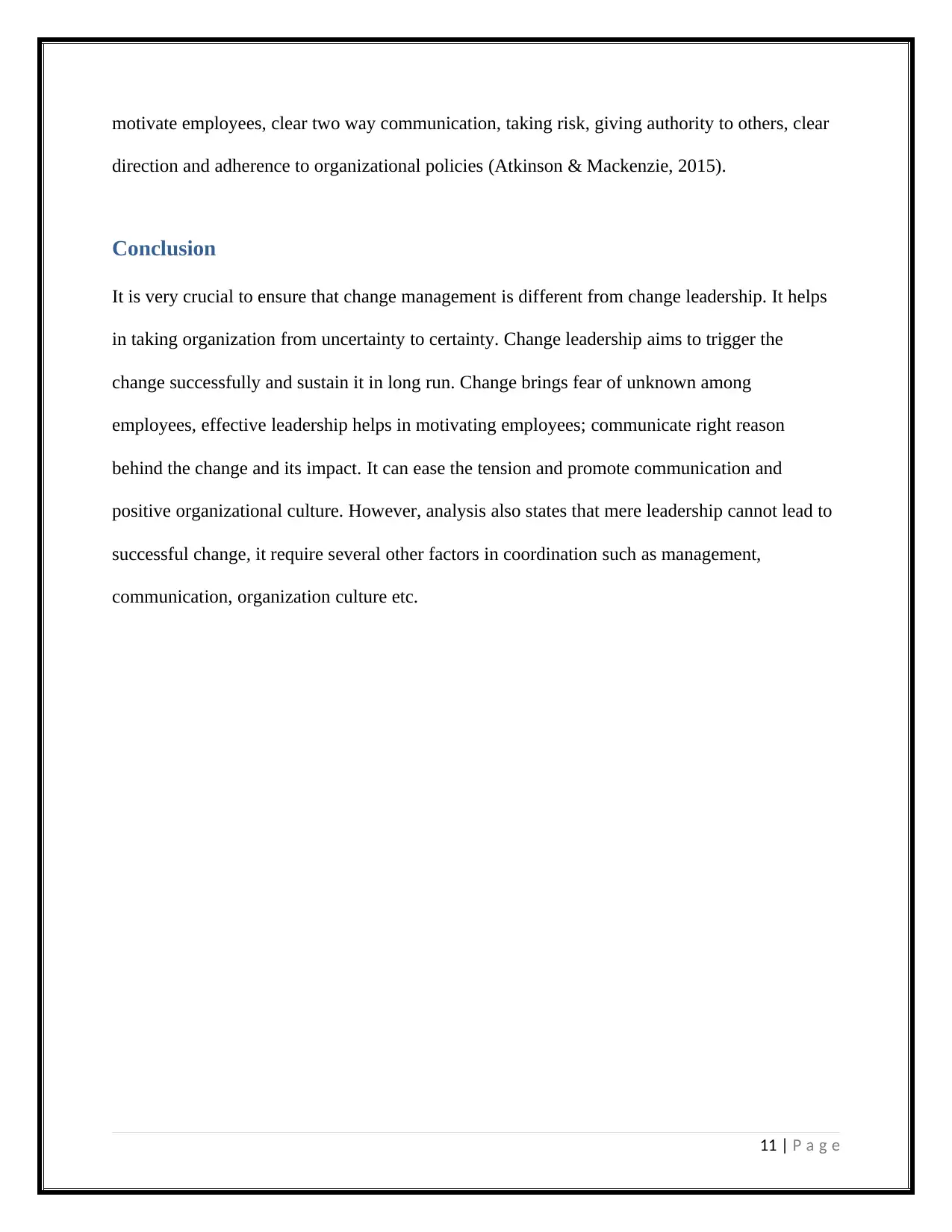
motivate employees, clear two way communication, taking risk, giving authority to others, clear
direction and adherence to organizational policies (Atkinson & Mackenzie, 2015).
Conclusion
It is very crucial to ensure that change management is different from change leadership. It helps
in taking organization from uncertainty to certainty. Change leadership aims to trigger the
change successfully and sustain it in long run. Change brings fear of unknown among
employees, effective leadership helps in motivating employees; communicate right reason
behind the change and its impact. It can ease the tension and promote communication and
positive organizational culture. However, analysis also states that mere leadership cannot lead to
successful change, it require several other factors in coordination such as management,
communication, organization culture etc.
11 | P a g e
direction and adherence to organizational policies (Atkinson & Mackenzie, 2015).
Conclusion
It is very crucial to ensure that change management is different from change leadership. It helps
in taking organization from uncertainty to certainty. Change leadership aims to trigger the
change successfully and sustain it in long run. Change brings fear of unknown among
employees, effective leadership helps in motivating employees; communicate right reason
behind the change and its impact. It can ease the tension and promote communication and
positive organizational culture. However, analysis also states that mere leadership cannot lead to
successful change, it require several other factors in coordination such as management,
communication, organization culture etc.
11 | P a g e
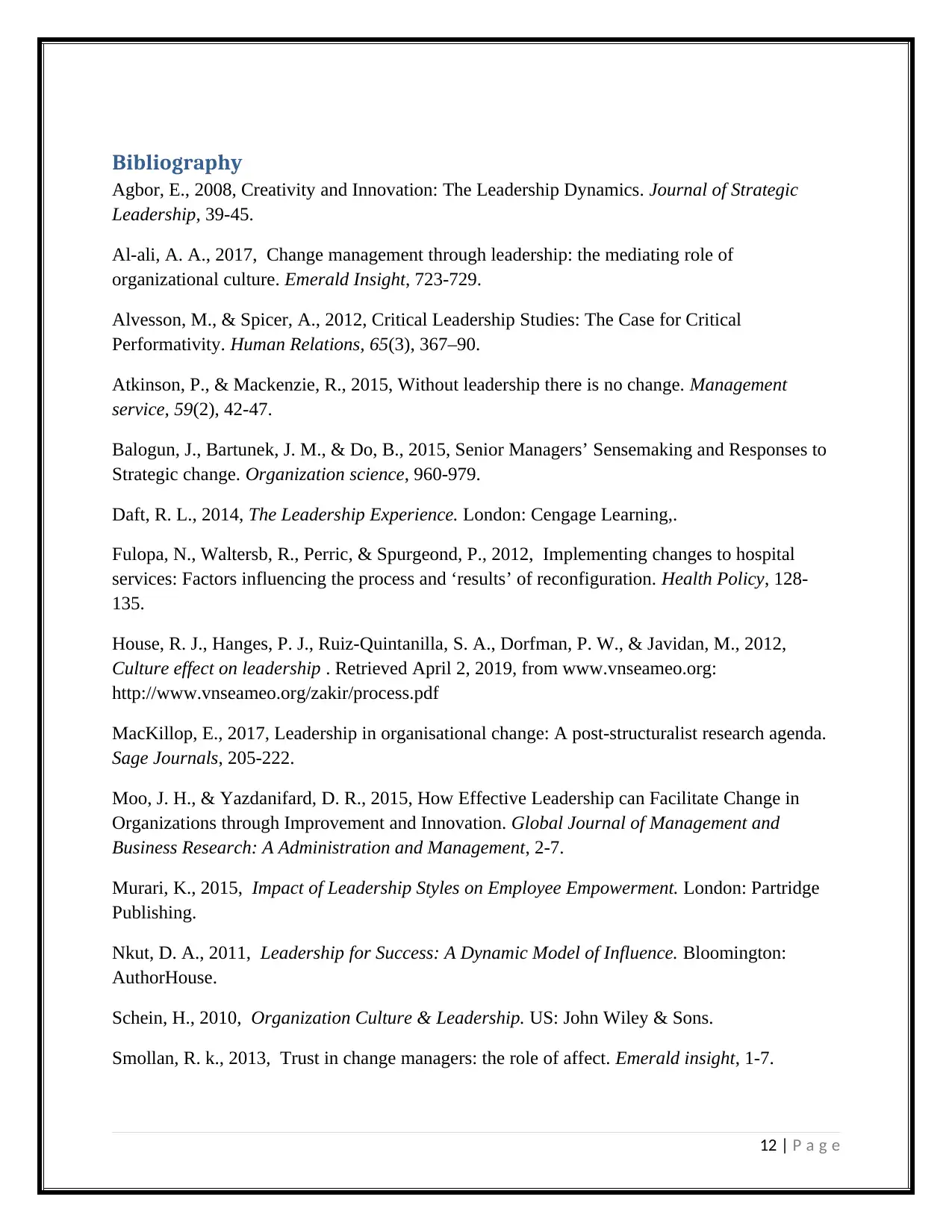
Bibliography
Agbor, E., 2008, Creativity and Innovation: The Leadership Dynamics. Journal of Strategic
Leadership, 39-45.
Al-ali, A. A., 2017, Change management through leadership: the mediating role of
organizational culture. Emerald Insight, 723-729.
Alvesson, M., & Spicer, A., 2012, Critical Leadership Studies: The Case for Critical
Performativity. Human Relations, 65(3), 367–90.
Atkinson, P., & Mackenzie, R., 2015, Without leadership there is no change. Management
service, 59(2), 42-47.
Balogun, J., Bartunek, J. M., & Do, B., 2015, Senior Managers’ Sensemaking and Responses to
Strategic change. Organization science, 960-979.
Daft, R. L., 2014, The Leadership Experience. London: Cengage Learning,.
Fulopa, N., Waltersb, R., Perric, & Spurgeond, P., 2012, Implementing changes to hospital
services: Factors influencing the process and ‘results’ of reconfiguration. Health Policy, 128-
135.
House, R. J., Hanges, P. J., Ruiz-Quintanilla, S. A., Dorfman, P. W., & Javidan, M., 2012,
Culture effect on leadership . Retrieved April 2, 2019, from www.vnseameo.org:
http://www.vnseameo.org/zakir/process.pdf
MacKillop, E., 2017, Leadership in organisational change: A post-structuralist research agenda.
Sage Journals, 205-222.
Moo, J. H., & Yazdanifard, D. R., 2015, How Effective Leadership can Facilitate Change in
Organizations through Improvement and Innovation. Global Journal of Management and
Business Research: A Administration and Management, 2-7.
Murari, K., 2015, Impact of Leadership Styles on Employee Empowerment. London: Partridge
Publishing.
Nkut, D. A., 2011, Leadership for Success: A Dynamic Model of Influence. Bloomington:
AuthorHouse.
Schein, H., 2010, Organization Culture & Leadership. US: John Wiley & Sons.
Smollan, R. k., 2013, Trust in change managers: the role of affect. Emerald insight, 1-7.
12 | P a g e
Agbor, E., 2008, Creativity and Innovation: The Leadership Dynamics. Journal of Strategic
Leadership, 39-45.
Al-ali, A. A., 2017, Change management through leadership: the mediating role of
organizational culture. Emerald Insight, 723-729.
Alvesson, M., & Spicer, A., 2012, Critical Leadership Studies: The Case for Critical
Performativity. Human Relations, 65(3), 367–90.
Atkinson, P., & Mackenzie, R., 2015, Without leadership there is no change. Management
service, 59(2), 42-47.
Balogun, J., Bartunek, J. M., & Do, B., 2015, Senior Managers’ Sensemaking and Responses to
Strategic change. Organization science, 960-979.
Daft, R. L., 2014, The Leadership Experience. London: Cengage Learning,.
Fulopa, N., Waltersb, R., Perric, & Spurgeond, P., 2012, Implementing changes to hospital
services: Factors influencing the process and ‘results’ of reconfiguration. Health Policy, 128-
135.
House, R. J., Hanges, P. J., Ruiz-Quintanilla, S. A., Dorfman, P. W., & Javidan, M., 2012,
Culture effect on leadership . Retrieved April 2, 2019, from www.vnseameo.org:
http://www.vnseameo.org/zakir/process.pdf
MacKillop, E., 2017, Leadership in organisational change: A post-structuralist research agenda.
Sage Journals, 205-222.
Moo, J. H., & Yazdanifard, D. R., 2015, How Effective Leadership can Facilitate Change in
Organizations through Improvement and Innovation. Global Journal of Management and
Business Research: A Administration and Management, 2-7.
Murari, K., 2015, Impact of Leadership Styles on Employee Empowerment. London: Partridge
Publishing.
Nkut, D. A., 2011, Leadership for Success: A Dynamic Model of Influence. Bloomington:
AuthorHouse.
Schein, H., 2010, Organization Culture & Leadership. US: John Wiley & Sons.
Smollan, R. k., 2013, Trust in change managers: the role of affect. Emerald insight, 1-7.
12 | P a g e
⊘ This is a preview!⊘
Do you want full access?
Subscribe today to unlock all pages.

Trusted by 1+ million students worldwide
1 out of 13
Related Documents
Your All-in-One AI-Powered Toolkit for Academic Success.
+13062052269
info@desklib.com
Available 24*7 on WhatsApp / Email
![[object Object]](/_next/static/media/star-bottom.7253800d.svg)
Unlock your academic potential
Copyright © 2020–2025 A2Z Services. All Rights Reserved. Developed and managed by ZUCOL.





